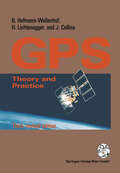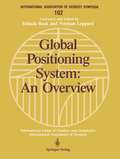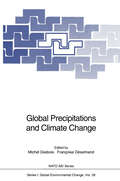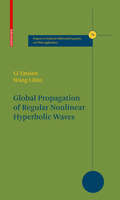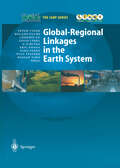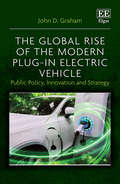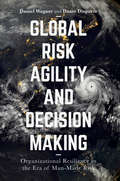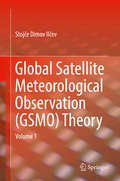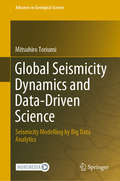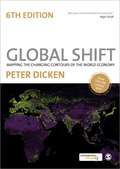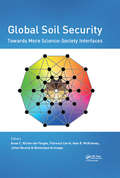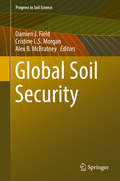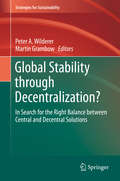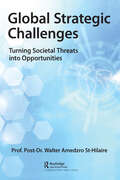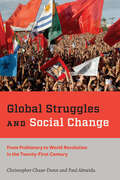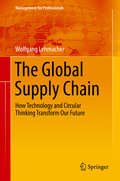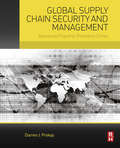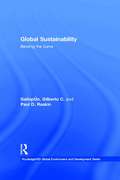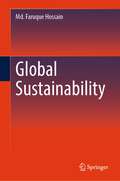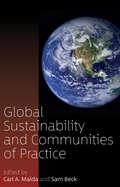- Table View
- List View
Global Positioning System: Theory and Practice
by Bernhard Hofmann-Wellenhof Herbert Lichtenegger James CollinsThis book is dedicated to Dr. Benjamin William Remondi for many reasons. The project of writing a Global Positioning System (GPS) book was con ceived in April 1988 at a GPS meeting in Darmstadt. Dr. Remondi discussed with me the need for an additional GPS textbook and suggested a possible joint effort. In 1989, I was willing to commit myself to such a project. Un fortunately, the timing was less than ideal for Dr. Remondi. Therefore, I decided to start the project with other coauthors. Dr. Remondi agreed and indicated his willingness to be a reviewer. I selected Dr. Herbert Lichtenegger, my colleague from the University of Technology at Graz, Austria, and Dr. James Collins from the United States. In my opinion, the knowledge of the three authors should cover the wide spectrum of GPS. Dr. Lichtenegger is a geodesist with broad experience in both theory and practice. He has specialized his research to geodetic astron omy including orbital theory and geodynamical phenomena. Since 1986, Dr. Lichtenegger's main interest is dedicated to GPS. Dr. Collins retired from the U.S. National Geodetic Survey in 1980, where he was the Deputy Director. For the past ten years, he has been deeply involved in using GPS technology with an emphasis on surveying. Dr. Collins was the founder and president of Geo/Hydro Inc. My own background is theoretically oriented. My first chief, Prof. Dr. Peter Meissl, was an excellent theoretician; and my former chief, Prof. DDDDr. Helmut Moritz, fortunately, still is.
Global Positioning System: Symposium No. 102 Edinburgh, Scotland, August 7–8, 1989 (International Association of Geodesy Symposia #102)
by Norman Leppard, Yehuda BockSpace geodesy has evolved in the last twenty years into one of the most exciting disciplines in the earth sciences. This development is due to a large extent to the versatility of applications provided by the radio interferometric technique called Global Positioning System or GPS. Appropriately, Symposium 102: Global Positioning System: An Overview was held at the 125th Anniversary Meeting of the International Association of Geodesy in August, 1989. A broad review of GPS geodesy, achievements to date and the prospects for future study and application was presented. Papers included in this volume are grouped as follows: - Static and Geodynamic Positioning; - Orbit Determination Optimization and Design Dynamic; - Kinematic GPS/INS Radio Tracking Systems A useful reference for any researcher or student of space geodesy.
Global Positioning System: A Field Guide for the Social Sciences
by John Spencer Brian G. Frizzelle Philip H. Page John B. VoglerGlobal Positioning System is the first book to guide social scientists with little or no mapping or GPS experience through the process of collecting field data from start to finish. Takes readers step-by-step through the key stages of a GPS fieldwork project. Explains complex background topics in clear, easy-to-understand language. Provides simple guidelines for GPS equipment selection. Provides practical solutions for real GPS data collection issues. Offers a concise guide to using GPS-collected data within geographic information systems.
Global Precipitations and Climate Change (Nato ASI Subseries I: #26)
by Michel Desbois Francoise DesalmandIn regard to global change, emphasis is generally placed on the increase in global temperature, but large changes in the distribution of precipitation are also likely to occur. Such changes have been redorded in the past by paleoclimatological studies or in the field of climatology. Different approaches to monitoring and forecasting the evolution of climate-scale precipitation are reviewed by paleoclimatologists, hydrologists, satellite meteorologists, and climate modellers.
Global Propagation of Regular Nonlinear Hyperbolic Waves (Progress in Nonlinear Differential Equations and Their Applications #76)
by Tatsien Li Wang LibinThis monograph describes global propagation of regular nonlinear hyperbolic waves described by first-order quasilinear hyperbolic systems in one dimension. The exposition is clear, concise, and unfolds systematically beginning with introductory material and leading to the original research of the authors. Topics are motivated with a number of physical examples from the areas of elastic materials, one-dimensional gas dynamics, and waves. Aimed at researchers and graduate students in partial differential equations and related topics, this book will stimulate further research and help readers further understand important aspects and recent progress of regular nonlinear hyperbolic waves.
Global-Regional Linkages in the Earth System (Global Change - The IGBP Series)
by Peter Tyson, Congbin Fu, Roland Fuchs, Louis Lebel, A. P. Mitra, Eric Odada, John Perry, Will Steffen and Hassan VirjiGlobal environmental change occupies a central niche in the pantheon of modern sciences. There is an urgent need to know and understand the way in which global biogeochemical cycles have changed over different time scales in the past and are likely to do so in the future. Equally important, it is necessary to determine the extent to which natural variability and that induce by anthropogenic activities are bringing about change. A number of international co-operative scientific programmes ad dress these issues. Chief among them are the International Geosphere-Biosphere Programme (IGBP), the World Climate Research Programme (WCRP) and the Inter national Human Dimensions Programme (IHDP) for global change. This book is one of a series of IGBP syntheses drawing together findings in global environmental change over the past decade or so. One focus of IGBP activities is the System for Analysis, Research and Training (START). Co-sponsored by the WCRP and IHDP, START establishes regional research networks for global change science in developing countries, stimulates and carries out global change research in developing regions of the world, and builds capacity to undertake such research at personal, institutional and regional levels. Several regional global change networks have been established, and much regional research has been accomplished in the last five years or so. In this book, work relating to four of the older START regions, Southern Africa, South Asia, Southeast Asia and East Asia, will be used as case studies to illustrate regional-global linkages in Earth System Science.
The Global Rise of the Modern Plug-In Electric Vehicle: Public Policy, Innovation and Strategy
by John D. GrahamWe may be standing at the precipice of a revolution in propulsion not seen since the internal combustion engine replaced the horse and buggy. The proliferation of electric cars will change the daily lives of motorists, boost some regional economies and hurt others, reduce oil insecurity but create new insecurities about raw materials, and impact urban air quality and climate change. If you want to understand how quickly the transition is likely to occur, and the factors shaping the pace of the transition, this book delivers with a candid, illuminating style. The invention of the lithium-ion battery and its adaptation to the auto sector set the stage for the exciting proliferation of electric cars, beginning with California and Norway. This book focuses on the period from the oil crises of the 1970s to the present, tracing the development of this entirely new industry and its critical supply chain. John Graham delves into the major societal concerns, economic rationales, governmental policies and corporate strategies. He emphasizes that consumer concerns slowed the pace of the transition while spurring more innovation and new policies to persuade reluctant consumers. And he explains why the transition is now occurring much faster in China and Europe than in Japan and the United States. More broadly, the book tells the story of many successes and failures in public policy, technological innovation and corporate strategy. This book provides an in-depth understanding of how people on every continent in the world are contributing to the new electric-vehicle industry, including the raw materials, battery components, electric motors and charging stations. Faculty, students and researchers will appreciate the integrated treatment of the technical, economic, political and international issues. For the practitioner in industry, government and civil society, the book is an engaging look at the roles of key decision makers and organizations, both those favoring electric cars and those opposed.
Global Risk Agility and Decision Making: Organizational Resilience in the Era of Man-Made Risk
by Daniel Wagner Dante DisparteIn Global Risk Agility and Decision Making, Daniel Wagner and Dante Disparte, two leading authorities in global risk management, make a compelling case for the need to bring traditional approaches to risk management and decision making into the twenty-first century. Based on their own deep and multi-faceted experience in risk management across numerous firms in dozens of countries, the authors call for a greater sense of urgency from corporate boards, decision makers, line managers, policymakers, and risk practitioners to address and resolve the plethora of challenges facing today’s private and public sector organizations.Set against the era of manmade risk, where transnational terrorism, cyber risk, and climate change are making traditional risk models increasingly obsolete, they argue that remaining passively on the side-lines of the global economy is dangerous, and that understanding and actively engaging the world is central to achieving risk agility. Their definition of risk agility taps into the survival and risk-taking instincts of the entrepreneur while establishing an organizational imperative focused on collective survival.The agile risk manager is part sociologist, anthropologist, psychologist, and quant. Risk agility implies not treating risk as a cost of doing business, but as a catalyst for growth. Wagner and Disparte bring the concept of risk agility to life through a series of case studies that cut across industries, countries and the public and private sectors. The rich, real-world examples underscore how once mighty organizations can be brought to their knees—and even their demise by simple miscalculations or a failure to just do the right thing. The reader is offered deep insights into specific risk domains that are shaping our world, including terrorism, cyber risk, climate change, and economic resource nationalism, as well as a frame of reference from which to think about risk management and decision making in our increasingly complicated world. This easily digestible book will shed new light on the often complex discipline of risk management. Readers will learn how risk management is being transformed from a business prevention function to a values-based framework for thriving in increasingly perilous times. From tackling governance structures and the tone at the top to advocating for greater transparency and adherence to value systems, this book will establish a new generation of risk leader, with clarion voices calling for greater risk agility. The rise of agile decision makers coincides with greater resilience and responsiveness in the era of manmade risk.
Global Risk-Based Management of Chemical Additives II: Risk-Based Assessment and Management Strategies (The Handbook of Environmental Chemistry)
by Bernd Bilitewski, Rosa Mari Darbra and Damià BarcelóChemical additives are used to enhance the properties of many industrial products. Since their release into the environment is a potential risk for man and nature, their fate and behavior have been investigated in the framework of the European Union-funded project RISKCYCLE. The results are presented in two volumes, Global Risk-Based Management of Chemical Additives I: Production, Usage and Environmental Occurrence and Global Risk-Based Management of Chemical Additives II: Risk-Based Assessment and Management Strategies. This book is the second of the two volumes and features two main parts. In the first part, experts in the field discuss different models related to the assessment of the potential risks posed by chemical additives and analyze their benefits and drawbacks. In the second part, specific case studies in which the models have been applied are presented and the reliability of the models is evaluated.This volume is an invaluable source of information for scientists and governmental agencies dealing with the risk assessment of chemicals on a global scale.
Global Satellite Meteorological Observation (GSMO) Theory: Volume 1
by Stojče Dimov IlčevThis book presents the principal structure of space systems, functionality, media and applications for modern remote sensing, transmission systems, meteorological antennas, propagation meteorological observation and transferring weather data from satellite to the ground infrastructures and users. The book starts with a short background to the development of Radio and Space systems including overview, concepts and applications of satellite communications in function of transfer meteorological observation data and images. It goes on to discuss the fundamental principles of the space platforms and orbital parameters, lows of satellite motions, new types of launching systems, satellite orbits and geometric relations, spacecraft configuration, payload structure, type of onboard antenna systems, satellite orbits and components of satellite bus. The author also provides comprehensive coverage of baseband and transmission systems, fundamentals of atmospheric electromagnetic radiation, satellite meteorological parameters and instruments, and research and applications in antenna systems and propagation. This is a companion book of Global Satellite Meteorological Observation Applications (Springer).
Global Seismicity Dynamics and Data-Driven Science: Seismicity Modelling by Big Data Analytics (Advances in Geological Science)
by Mitsuhiro ToriumiThe recent explosion of global and regional seismicity data in the world requires new methods of investigation of microseismicity and development of their modelling to understand the nature of whole earth mechanics. In this book, the author proposes a powerful tool to reveal the characteristic features of global and regional microseismicity big data accumulated in the databases of the world. The method proposed in this monograph is based on (1) transformation of stored big data to seismicity density data archives, (2) linear transformation of microseismicity density data matrixes to correlated seismicity matrixes by means of the singular value decomposition method, (3) time series analyses of globally and regionally correlated seismicity rates, and (4) the minimal non-linear equations approximation of their correlated seismicity rate dynamics. Minimal non-linear modelling is the manifestation for strongly correlated seismicity time series controlled by Langevin-type stochastic dynamic equations involving deterministic terms and random Gaussian noises. A deterministic term is composed minimally with correlated seismicity rate vectors of a linear term and of a term with a third exponent. Thus, the dynamics of correlated seismicity in the world contains linearly changing stable nodes and rapid transitions between them with transient states. This book contains discussions of future possibilities of stochastic extrapolations of global and regional seismicity in order to reduce earthquake disasters worldwide. The dataset files are available online and can be downloaded at springer.com.
Global Shift: Mapping the Changing Contours of the World Economy (PDF)
by Peter DickenThis sixth edition of Global Shift has been completely revised and updated using the latest available sources. Each chapter has been extensively rewritten and new chapters introduced to take account of recent empirical developments, new ideas on production, distribution, and consumption in the global economy and the implications of the global financial crisis. The now standard work on economic globalization provides: the most comprehensive and up-to-date explanation of economic globalization available, examining the role of transnational corporations, states, labour, consumers, and organizations in civil society and the power relations between them a clear guide to how the global economy is being transformed through the operation of global production networks involving transnational corporations, states and interest groups and technology detailed discussion of different theories of economic globalization a new chapter on the environmental impacts of globalizing processes extended discussion of problems and institutions of global governance in the context of the global economic crisis and of the role of corporate social responsibility broadened sectoral case studies including a new case study on resource-extractive industries an extended chapter on financial and advanced business services. The extensive use of graphics, lack of jargon and clear definition of terms, makes Global Shift the key resource on economic globalization in the social science literature.
Global Soil Security: Proceedings of the Global Soil Security 2016 Conference, December 5-6, 2016, Paris, France
by Dominique Arrouays Florence Carre Anne Richer De Forges Alex B. McBratneyGlobal Soil Security: Towards More Science-Society Interfaces contains contributions presented at the 2nd Global Soil Security conference, held 5-6 December 2016 in Paris. These chapters focus on how to achieve soil security. This involves scientific, economic, industrial and political engagement to inform soil-users, policy makers and citizens with the objective of implementing appropriate actions. The contributions to this book address the five dimensions of soil security, namely: capability, condition, capital, connectivity and codification.
Global Soil Security: Soil Science-society Interfaces: Proceedings Of The 2nd Global Soil Security Conference, December 5-6, 2016, Paris, France (Progress in Soil Science)
by Damien J. Field, Cristine L. S. Morgan and Alex B. McBratneyThis book introduces the concept of soil security and its five dimensions: Capability, Capital, Condition, Connectivity and Codification. These five dimensions make it possible to understand soil's role in delivering ecosystem services and to quantify soil resource by measuring, mapping, modeling and managing it. Each dimension refers to a specific aspect: contribution to global challenges (Capability), value of the soil (Capital), current state of the soil (Condition), how people are connected to the soil (Connectivity) and development of good policy (Codification). This book considers soil security as an integral part of meeting the ongoing challenge to maintain human health and secure our planet's sustainability. The concept of soil security helps to achieve the need to maintain and improve the world’s soil for the purpose of producing food, fiber and freshwater, and contributing to energy and climate sustainability. At the same time it helps to maintain biodiversity and protectsecosystem goods and services.
Global Stability through Decentralization?: In Search for the Right Balance between Central and Decentral Solutions (Strategies for Sustainability)
by Peter A. Wilderer Martin GrambowThe authors of this book, who represent a broad range of scientific disciplines, discuss the issue of centralized versus decentralized control and regulation in the context of sustainable development. The stability and resilience of complex technical, economic, societal and political systems are commonly assumed to be highly dependent on the effectiveness of sophisticated, mainly centralized regulation and control systems and governance structures, respectively. In nature, however, life is mainly self-regulated by widespread, mainly DNA-encoded control mechanisms. The fact that life has endured for more than 2.4 billion years suggests that, for man-made systems, decentralized control concepts are superior to centralized ones. The authors discuss benefits and drawbacks of both approaches to achieving sustainability, providing valuable information for students and professional decision makers alike.
Global Strategic Challenges: Turning Societal Threats into Opportunities
by Walter Amedzro St-HilaireFrom his position as a Senior Fellow, the author addresses in this book the structural challenges and difficulties that predate Covid pandemic: climate change, economic inequality and the demographic challenge. These challenges raise fundamental questions of equity both between and within generations. Their immediate effects are much weaker than their long-term effects, which encourages policymakers to delay. But the cost of meeting them increases over time. These menaces raise complex technical and economic issues; some decisions must be made under great uncertainty. For each of these challenges, solutions exist: why is there little progress and how to turning threats into opportunities? In all cases, technological change is a central aspect, constituting both part of the problem and part of the solution. The solutions the author formulates are of two kinds: policy recommendations and exploratory strategic proposals. Some of the recommendations include measures that have been widely discussed but never implemented. The author wonders why these measures were never implemented? Some of the strategies are more exploratory in nature because they are new or their effects are less well understood, or because the risks associated with their implementation are significant. The author effectively analyzes the different options for exiting the crisis and explains how his proposals differ from the current reforms for global warming, inequality and population aging.
Global Strategic Challenges: Turning Societal Threats into Opportunities
by Walter Amedzro St-HilaireFrom his position as a Senior Fellow, the author addresses in this book the structural challenges and difficulties that predate Covid pandemic: climate change, economic inequality and the demographic challenge. These challenges raise fundamental questions of equity both between and within generations. Their immediate effects are much weaker than their long-term effects, which encourages policymakers to delay. But the cost of meeting them increases over time. These menaces raise complex technical and economic issues; some decisions must be made under great uncertainty. For each of these challenges, solutions exist: why is there little progress and how to turning threats into opportunities? In all cases, technological change is a central aspect, constituting both part of the problem and part of the solution. The solutions the author formulates are of two kinds: policy recommendations and exploratory strategic proposals. Some of the recommendations include measures that have been widely discussed but never implemented. The author wonders why these measures were never implemented? Some of the strategies are more exploratory in nature because they are new or their effects are less well understood, or because the risks associated with their implementation are significant. The author effectively analyzes the different options for exiting the crisis and explains how his proposals differ from the current reforms for global warming, inequality and population aging.
Global Struggles and Social Change: From Prehistory to World Revolution in the Twenty-First Century
by Christopher Chase-Dunn Paul AlmeidaIn the early decades of the twenty-first century, an international movement to slow the pace of climate change mushroomed across the globe. The self-proclaimed Climate Justice movement urges immediate action to reduce carbon emissions and calls for the adoption of bold new policies to address global warming before irreversible and catastrophic damage threatens the habitability of the planet. On another front, since the 1980s, multiple waves of resistance have occurred around the world against the uneven transition from state-led development to the neoliberal globalization project. Both Climate Justice and Anti-Austerity movements represent the urgency of understanding how global change affects the ability of citizens around the world to mobilize and protect themselves from planetary warming and the loss of social protections granted in earlier eras.In Global Struggles and Social Change, Christopher Chase-Dunn and Paul Almeida explore how global change stimulates the formation and shape of such movements. Contending that large-scale economic shifts condition the pattern of social movement mobilizations around the world, the authors trace these trends back to premodern societies, revealing how severe disruptions of indigenous communities led to innovative collective actions throughout history. Drawing on historical case studies, world system and protest event analysis, and social networks, they also examine the influence of global change processes on local, national, and transnational social movements and explain how in turn these movements shape institutional shifts. Touching on hot-button topics, including global warming, immigrant rights protests, the rise of right-wing populism, and the 2008 financial crisis, the book also explores a broad range of premodern social movements from indigenous people in the Americas, Mesopotamia, and China. The authors pay special attention to periods of disruption and external threats, as well as the role of elites, emotions, charisma, and religion or spirituality in shaping protest movements. Providing sweeping coverage, Global Struggles and Social Change is perfect for students and anyone interested in globalization, international and comparative politics, political sociology, and communication studies.
Global Struggles and Social Change: From Prehistory to World Revolution in the Twenty-First Century
by Christopher Chase-Dunn Paul AlmeidaIn the early decades of the twenty-first century, an international movement to slow the pace of climate change mushroomed across the globe. The self-proclaimed Climate Justice movement urges immediate action to reduce carbon emissions and calls for the adoption of bold new policies to address global warming before irreversible and catastrophic damage threatens the habitability of the planet. On another front, since the 1980s, multiple waves of resistance have occurred around the world against the uneven transition from state-led development to the neoliberal globalization project. Both Climate Justice and Anti-Austerity movements represent the urgency of understanding how global change affects the ability of citizens around the world to mobilize and protect themselves from planetary warming and the loss of social protections granted in earlier eras.In Global Struggles and Social Change, Christopher Chase-Dunn and Paul Almeida explore how global change stimulates the formation and shape of such movements. Contending that large-scale economic shifts condition the pattern of social movement mobilizations around the world, the authors trace these trends back to premodern societies, revealing how severe disruptions of indigenous communities led to innovative collective actions throughout history. Drawing on historical case studies, world system and protest event analysis, and social networks, they also examine the influence of global change processes on local, national, and transnational social movements and explain how in turn these movements shape institutional shifts. Touching on hot-button topics, including global warming, immigrant rights protests, the rise of right-wing populism, and the 2008 financial crisis, the book also explores a broad range of premodern social movements from indigenous people in the Americas, Mesopotamia, and China. The authors pay special attention to periods of disruption and external threats, as well as the role of elites, emotions, charisma, and religion or spirituality in shaping protest movements. Providing sweeping coverage, Global Struggles and Social Change is perfect for students and anyone interested in globalization, international and comparative politics, political sociology, and communication studies.
The Global Supply Chain: How Technology and Circular Thinking Transform Our Future (Management for Professionals)
by Wolfgang LehmacherThis book provides readers an in-depth understanding of the inner mechanisms and principles of the global supply chain. Authored by the Head of Supply Chain and Transport Industries at the World Economic Forum, it draws on a wealth of operational and managerial expertise in the global supply chain industry that drive the world’s economies. The book analyzes the importance and impact of globally networked sourcing, production and distribution, and presents detailed information on the opportunities, limitations and challenges of linear value and supply chain systems. Building on a series of recent industry cases and with a focus on the latest developments in actual business processes and models, it reveals how the transformation toward circular supply chains and regenerative resource management forms the basis for success and sustainability in business.“The book brings together technical, social, political, and geographical trends, suggesting how supply chain management can lead the quest for many of the world’s most pressing challenges.” Yossi Sheffi, Professor of Engineering, MIT, Head, MIT Center for Transportation and Logistics“This book provides an essential roadmap, guiding the reader easily through complex developments and concepts.” John Manners-Bell, CEO Transport Intelligence and Honorary Visiting Professor, Guildhall Business School, London “With strategic foresight, Lehmacher develops a vision of a circular economy within which consumer, manufacturer and logistics companies assume collective responsibility for sustainable value creation.” Alfred Talke, Group Managing Director ALFRED TALKE Logistic Services “Those who are active in logistics and supply chain management, in practice or academia, will discover a fresh view on the whole field of activity beyond the day-to-day-business.” Prof. Dr.-Ing. Thomas Wimmer, Chairman of the Executive Board, BVL International
Global Supply Chain Security and Management: Appraising Programs, Preventing Crimes
by Darren ProkopGlobal Supply Chain Security and Management: Appraising Programs, Preventing Crimes examines the relationship between securing a supply chain and promoting more efficient worldwide trade. Historically, the primary goal of supply chain security was guarding against theft and damage. Today, supply chains are also on the frontlines in the fight against terrorism. This book showcases industry leaders and their best practices, also exploring how the government is both a policing organization and a supply chain partner. In addition, it covers the critical roles that various technologies play, focusing on how Big Data is collected and turned into knowledge. By using the tools provided, readers will gain a stronger understanding of the challenges and opportunities faced by any organization that imports or exports products.Outlines the latest technologies being used to secure infrastructuresLeverages game theory to express the strategic interactions of government and businessCovers the latest U.S. regulations and provides analytical tools to help make sense of these regulationsIncorporates the latest theories and techniques of industrial organization, economics, and security
Global Sustainability: Bending the Curve (Routledge/SEI Global Environment and Development Series #Vol. 3)
by Gilberto C. Gallopín Paul D. RaskinUnprecedented levels of wealth, technology and institutional capacity can forge a just, peaceful and ecologically resilient future. However, the authors argue, social polarization, geo-political conflict and environmental degradation are threatening the long-term well-being of humanity and the planet. Global Sustainability explores the alternative futures that could emerge from the resolution of these antagonisms. Based on extensive international and interdisciplinary research, the book identifies the perils of market-driven scenarios and considers the possibility of the failure of conventional approaches. It also, however, presents a vision of the possibility of a 'Great Transition' in which revised human values and development goals bring a new stage of civilization. It will be essential reading for all scholars and professionals interested in the future of the environment, international affairs, and sustainable development.
Global Sustainability: Bending the Curve (Routledge/SEI Global Environment and Development Series)
by Gilberto C. Gallopín Paul D. RaskinUnprecedented levels of wealth, technology and institutional capacity can forge a just, peaceful and ecologically resilient future. However, the authors argue, social polarization, geo-political conflict and environmental degradation are threatening the long-term well-being of humanity and the planet. Global Sustainability explores the alternative futures that could emerge from the resolution of these antagonisms. Based on extensive international and interdisciplinary research, the book identifies the perils of market-driven scenarios and considers the possibility of the failure of conventional approaches. It also, however, presents a vision of the possibility of a 'Great Transition' in which revised human values and development goals bring a new stage of civilization. It will be essential reading for all scholars and professionals interested in the future of the environment, international affairs, and sustainable development.
Global Sustainability
by Md. Faruque HossainThis book focuses on holistic approaches to sustainability in all sectors of environment, energy, building, and infrastructure to achieve the best-balanced global environmental, energy, building, infrastructure, transportation, and water technologies (EBITWs). It presents a series of solutions based on innovative research and applications for building a sustainable Earth for future generations. Simply, the goal of this book is to define the context of instigation to think through the scientific theories and practical technical applications of sustainability for building a better planet. Naturally this book explains a series of mechanisms to develop a sustainable world by implementing mainly practicing the following areas of Sustainable Energy, Sustainable Housing and Building Technology, Sustainable Water, Infrastructure, and Transportation Technology, Sustainable Environment which are, very much interconnected to secure a global environmental equilibrium.
Global Sustainability and Communities of Practice
by Carl A. Maida Sam BeckCollaboration between experts and the public is vital for effective community engagement aimed at improving the lives of the most vulnerable in society, whether at the local or global level. Using case-based and theoretical chapters that examine rural and urban communities of practice, this volume illustrates how participatory researchers and students, as well as policy and community leaders, find ways to engage with the broader public when it comes to global sustainability research and practice.
